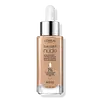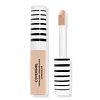What's inside
What's inside
 Key Ingredients
Key Ingredients

 Benefits
Benefits

 Concerns
Concerns

 Ingredients Side-by-side
Ingredients Side-by-side

Water
Skin ConditioningIsododecane
EmollientDimethicone
EmollientAlcohol Denat.
AntimicrobialTrimethylsiloxysilicate
EmollientButylene Glycol
HumectantPEG-10 Dimethicone
Skin ConditioningPerlite
AbsorbentSodium Hyaluronate
HumectantNylon-12
Isopropyl Lauroyl Sarcosinate
Skin ConditioningDiisopropyl Sebacate
EmollientDisteardimonium Hectorite
StabilisingHdi/Trimethylol Hexyllactone Crosspolymer
Bis-PEG/PPG-14/14 Dimethicone
EmollientMagnesium Sulfate
Synthetic Fluorphlogopite
Ethylhexyl Hydroxystearate
EmollientPhenoxyethanol
PreservativeCellulose
AbsorbentDipentaerythrityl Tetrahydroxystearate/Tetraisostearate
Skin ConditioningSilica
AbrasiveSilica Silylate
EmollientDisodium Stearoyl Glutamate
CleansingCalcium Carbonate
AbrasiveCalcium Aluminum Borosilicate
Tocopherol
AntioxidantMoroccan Lava Clay
AbrasiveGlycerin
HumectantEmpetrum Nigrum Fruit Juice
Skin ConditioningAluminum Hydroxide
EmollientPotassium Sorbate
PreservativeCI 77491
Cosmetic ColorantCI 77492
Cosmetic ColorantCI 77499
Cosmetic ColorantCeramide AP
Skin ConditioningWater, Isododecane, Dimethicone, Alcohol Denat., Trimethylsiloxysilicate, Butylene Glycol, PEG-10 Dimethicone, Perlite, Sodium Hyaluronate, Nylon-12, Isopropyl Lauroyl Sarcosinate, Diisopropyl Sebacate, Disteardimonium Hectorite, Hdi/Trimethylol Hexyllactone Crosspolymer, Bis-PEG/PPG-14/14 Dimethicone, Magnesium Sulfate, Synthetic Fluorphlogopite, Ethylhexyl Hydroxystearate, Phenoxyethanol, Cellulose, Dipentaerythrityl Tetrahydroxystearate/Tetraisostearate, Silica, Silica Silylate, Disodium Stearoyl Glutamate, Calcium Carbonate, Calcium Aluminum Borosilicate, Tocopherol, Moroccan Lava Clay, Glycerin, Empetrum Nigrum Fruit Juice, Aluminum Hydroxide, Potassium Sorbate, CI 77491, CI 77492, CI 77499, Ceramide AP
Water
Skin ConditioningIsododecane
EmollientCyclopentasiloxane
EmollientTalc
AbrasiveTrimethylsiloxysilicate
EmollientButylene Glycol
HumectantCetyl PEG/PPG-10/1 Dimethicone
EmulsifyingCetearyl Ethylhexanoate
EmollientAcrylates Crosspolymer
AbsorbentDimethicone/Vinyl Dimethicone Crosspolymer
Skin ConditioningMagnesium Sulfate
Bis-PEG/PPG-14/14 Dimethicone
EmollientBoron Nitride
AbsorbentAmmonium Acrylates Copolymer
Tribehenin
EmollientIsopropyl Titanium Triisostearate
EmollientDisteardimonium Hectorite
StabilisingLaureth-7
EmulsifyingLecithin
EmollientPhenoxyethanol
PreservativeTrihydroxystearin
Skin ConditioningChlorphenesin
AntimicrobialPropylene Carbonate
SolventXanthan Gum
EmulsifyingAlcohol Denat.
AntimicrobialGlycerin
HumectantTocopheryl Acetate
AntioxidantDisodium EDTA
Disodium Deceth-6 Sulfosuccinate
CleansingSodium PCA
HumectantUrea
BufferingLaureth-30
CleansingSodium Dehydroacetate
PreservativeTrehalose
HumectantHexylene Glycol
EmulsifyingPolyquaternium-51
Skin ConditioningCaprylyl Glycol
EmollientTriacetin
AntimicrobialSodium Hyaluronate
HumectantPentaerythrityl Tetra-Di-T-Butyl Hydroxyhydrocinnamate
AntioxidantCI 77891
Cosmetic ColorantIron Oxides
Water, Isododecane, Cyclopentasiloxane, Talc, Trimethylsiloxysilicate, Butylene Glycol, Cetyl PEG/PPG-10/1 Dimethicone, Cetearyl Ethylhexanoate, Acrylates Crosspolymer, Dimethicone/Vinyl Dimethicone Crosspolymer, Magnesium Sulfate, Bis-PEG/PPG-14/14 Dimethicone, Boron Nitride, Ammonium Acrylates Copolymer, Tribehenin, Isopropyl Titanium Triisostearate, Disteardimonium Hectorite, Laureth-7, Lecithin, Phenoxyethanol, Trihydroxystearin, Chlorphenesin, Propylene Carbonate, Xanthan Gum, Alcohol Denat., Glycerin, Tocopheryl Acetate, Disodium EDTA, Disodium Deceth-6 Sulfosuccinate, Sodium PCA, Urea, Laureth-30, Sodium Dehydroacetate, Trehalose, Hexylene Glycol, Polyquaternium-51, Caprylyl Glycol, Triacetin, Sodium Hyaluronate, Pentaerythrityl Tetra-Di-T-Butyl Hydroxyhydrocinnamate, CI 77891, Iron Oxides
 Reviews
Reviews

Ingredients Explained
These ingredients are found in both products.
Ingredients higher up in an ingredient list are typically present in a larger amount.
Alcohol Denat. is an alcohol with a denaturant property. It is created by mixing ethanol with other additives.
This ingredient gets a bad rep because it is irritating and drying - mostly due to its astringent property. Astringents draw out natural oils in tissue, constricting pores and leaving your skin dried out.
However, alcohol denat. is not all that bad.
Due to its low molecular weight, alcohol denat. tends to evaporate quickly. One study on pig skin found half of applied alcohol evaporated in 10 seconds and less than 3% stayed on skin.
This also helps other ingredients become better absorbed upon application.
Studies are conflicted about whether this ingredient causes skin dehydration. One study from 2005 found adding emollients to propanol-based sanitizer decreased skin dryness and irritation. Another study found irritation only occurs if your skin is already damaged.
Small amounts of alcohol are generally tolerated by oily skin or people who live in humid environments.
The rule of thumb is if this alcohol is near the end of an ingredients list, it will probably not affect your skin much.
Also...
This ingredient has antimicrobial and solvent properties.
The antimicrobial property helps preserve products and increase their shelf life. As a solvent, it helps dissolve other ingredients.
Other types of astringent alcohols include:
Learn more about Alcohol Denat.Bis-PEG/PPG-14/14 Dimethicone is a type of silicone.
Butylene Glycol (or BG) is used within cosmetic products for a few different reasons:
Overall, Butylene Glycol is a safe and well-rounded ingredient that works well with other ingredients.
Though this ingredient works well with most skin types, some people with sensitive skin may experience a reaction such as allergic rashes, closed comedones, or itchiness.
Learn more about Butylene GlycolDisteardimonium Hectorite comes from the clay mineral named hectorite. It is used to add thickness to a product.
It can also help stabilize a product by helping to disperse other ingredients.
Hectorite is a rare, white clay mineral.
Learn more about Disteardimonium HectoriteGlycerin is already naturally found in your skin. It helps moisturize and protect your skin.
A study from 2016 found glycerin to be more effective as a humectant than AHAs and hyaluronic acid.
As a humectant, it helps the skin stay hydrated by pulling moisture to your skin. The low molecular weight of glycerin allows it to pull moisture into the deeper layers of your skin.
Hydrated skin improves your skin barrier; Your skin barrier helps protect against irritants and bacteria.
Glycerin has also been found to have antimicrobial and antiviral properties. Due to these properties, glycerin is often used in wound and burn treatments.
In cosmetics, glycerin is usually derived from plants such as soybean or palm. However, it can also be sourced from animals, such as tallow or animal fat.
This ingredient is organic, colorless, odorless, and non-toxic.
Glycerin is the name for this ingredient in American English. British English uses Glycerol/Glycerine.
Learn more about GlycerinIsododecane is a fragrance, emollient, and solvent.
As an emollient, it helps your skin stay soft and hydrated. Emollients help trap moisture into your skin.
Isododecane's role as a solvent makes it a great texture enhancer. It spreads smoothly on skin and does not leave a sticky feeling behind. Isododecane also helps prevent color transfer in makeup products.
Isododecane is not absorbed into skin.
Learn more about IsododecaneMagnesium Sulfate is a salt. More specifically, it is an epsom salt, or the bath salt used to help relieve muscle aches.
Despite having ‘sulfate’ in the name, it isn’t a surfactant or cleansing agent like sodium lauryl sulfate. Unlike those sulfates, magnesium sulfate doesn’t have the same cleansing or foaming properties (it's simply a type of salt).
In cosmetics, Magnesium Sulfate is used to thicken a product or help dilute other solids. It is a non-reactive and non-irritating ingredient.
One study shows magnesium deficiency may lead to inflammation of the skin. Applying magnesium topically may help reduce inflammation.
You can find this ingredient in sea water or mineral deposits.
Learn more about Magnesium SulfatePhenoxyethanol is a preservative that has germicide, antimicrobial, and aromatic properties. Studies show that phenoxyethanol can prevent microbial growth. By itself, it has a scent that is similar to that of a rose.
It's often used in formulations along with Caprylyl Glycol to preserve the shelf life of products.
Sodium Hyaluronate is hyaluronic acid's salt form. It is commonly derived from the sodium salt of hyaluronic acid.
Like hyaluronic acid, it is great at holding water and acts as a humectant. This makes it a great skin hydrating ingredient.
Sodium Hyaluronate is naturally occurring in our bodies and is mostly found in eye fluid and joints.
These are some other common types of Hyaluronic Acid:
Learn more about Sodium HyaluronateThis silicone is an emollient. Emollients create a thin film on the skin to prevent moisture from escaping.
It is not soluble in water and helps increase water-resistance in products.
According to a manufacturer, it can blend seamlessly with silicone oils, such as Cyclopentasiloxane.
Learn more about TrimethylsiloxysilicateWater. It's the most common cosmetic ingredient of all. You'll usually see it at the top of ingredient lists, meaning that it makes up the largest part of the product.
So why is it so popular? Water most often acts as a solvent - this means that it helps dissolve other ingredients into the formulation.
You'll also recognize water as that liquid we all need to stay alive. If you see this, drink a glass of water. Stay hydrated!
Learn more about Water